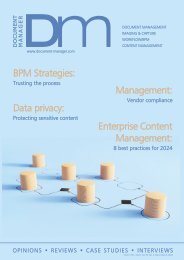CC Sep-Oct 2023
You also want an ePaper? Increase the reach of your titles
YUMPU automatically turns print PDFs into web optimized ePapers that Google loves.
CASEstudy<br />
SEQUENCING A PROGRAMME<br />
WITH PIONEERING TECHNIQUES<br />
The hotel's extension plans carried<br />
significant risks. The new mega<br />
basement was situated directly<br />
underneath Claridge's Art Deco<br />
extension, constructed in the 1920s on a<br />
single reinforced concrete slab. McGee's<br />
Project Director, Jim Mackey, developed<br />
a creative construction plan to be<br />
executed by Project Engineer Michelle<br />
Mackey (who is also Jim's daughter).<br />
"We did some trial works to determine<br />
what the existing building structure was<br />
made of and what was and wasn't<br />
possible, then Jim sat down with our<br />
technical department and put together a<br />
3D animation of the sequence."<br />
With the high-level sequence mapped<br />
out, Jim handed the project to Michelle,<br />
who needed to turn a static plan into<br />
something more dynamic. Michelle<br />
chose Asta Powerproject planning and<br />
project management software to rise to<br />
this challenge.<br />
"Asta Powerproject enabled me to put<br />
in the detail we needed and then roll the<br />
programme up, so we could still present<br />
a high-level view. We didn't need<br />
everyone to see tasks hour by hour, but<br />
going into that level of detail meant we<br />
could flag any potential issues early on."<br />
The Claridge's project was divided into<br />
multiple phases, starting with a team of<br />
miners hand-digging a network of<br />
tunnels directly underneath the hotel.<br />
They dug down 30 metres to create a<br />
series of shafts that would become the<br />
hotel's new foundations.<br />
Concrete was poured into the shafts to<br />
create the new foundations, and new<br />
columns were constructed from within<br />
the shafts for the existing hotel building<br />
to rest on. Then the team excavated 500<br />
cubic metres of earth from around the<br />
columns, using heavy machinery<br />
assembled underground, to construct<br />
the new five-story basement.<br />
"Once I set up the programme in Asta<br />
Powerproject and tested the first few<br />
lines, I felt confident that I could<br />
sequence the project from start to finish<br />
and there wouldn't be any errors,"<br />
Michelle added.<br />
MANAGING COMPLEX TIME AND<br />
MATERIAL SCHEDULES<br />
It wasn't just construction techniques<br />
that challenged McGee. Working on a<br />
landmark building in the middle of<br />
London also presented logistics<br />
challenges, as the excavation work<br />
involved removing 45,000 tonnes of clay<br />
through one hole just 2.5 metres wide.<br />
McGee could not store waste material<br />
on-site due to insufficient space.<br />
Instead, materials had to be moved to<br />
and from Claridge's daily from a nearby<br />
holding yard, with a single loading area<br />
on-site. Asta Powerproject delivered the<br />
precision planning needed to ensure<br />
materials were collected on schedule,<br />
preventing programme delays.<br />
"The Claridge's project was very<br />
complex by nature. We had one space<br />
to work in, and all our equipment and<br />
materials came in and out of one<br />
opening. Asta Powerproject allowed us<br />
to take just-in-time material planning to<br />
the extreme."<br />
The project also involved coordinating<br />
tradespeople working two different shift<br />
patterns. While standard building<br />
contractors worked Monday-Friday,<br />
8am-6pm, two teams of miners worked<br />
seven days in alternating 12-hour shifts.<br />
McGee used Asta Powerproject to<br />
coordinate site resources with material<br />
requirements, managing the pace of<br />
work to synchronise deliveries with their<br />
progress. "We never wanted to be in a<br />
situation where teams arrived for their<br />
shift and the materials that they needed<br />
weren't available. Or a situation where<br />
we couldn't get materials in fast enough.<br />
With Asta Powerproject, we could drop a<br />
line down the programme to monitor<br />
and adjust progress on a daily basis,"<br />
said Mackey.<br />
Some material deliveries were timecritical,<br />
like the thousands of tonnes of<br />
concrete needed for the basement<br />
columns. Michelle's team needed to<br />
ensure that mining work finished at a<br />
time when concrete could be delivered<br />
to fill each shaft as quickly as possible.<br />
"We used Asta Powerproject to<br />
coordinate both timings and logistics.<br />
For example, we couldn't have mining<br />
teams finishing on a Saturday night and<br />
then the base of each shaft being left<br />
open for 30 hours until the concrete<br />
could arrive."<br />
COORDINATING CONSTRUCTION IN<br />
THE PRESENCE OF PAYING GUESTS<br />
If project logistics weren't challenging<br />
enough, McGee also had to coordinate<br />
site activity around what was happening<br />
in the hotel. In addition to ensuring<br />
<strong>Sep</strong>tember/<strong>Oct</strong>ober <strong>2023</strong> 11

















